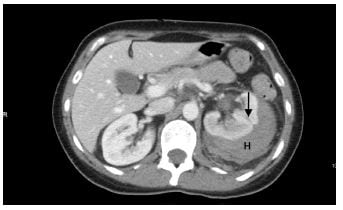| Author | Affiliation |
|---|---|
| Sam S. Torbati, MD | Cedars-Sinai Medical Center, Department of Emergency Medicine, Los Angeles, California |
| Michelle Niku, BS | Cedars-Sinai Medical Center, Department of Emergency Medicine, Los Angeles, California |
| Elaine Vos, BA | Cedars-Sinai Medical Center, Department of Emergency Medicine, Los Angeles, California |
| Shomari Hogan, MD | Cedars-Sinai Medical Center, Department of Emergency Medicine, Los Angeles, California |
ABSTRACT
A 41-year-old woman presented to the emergency department with a chief complaint of hematuria three days status post extracorporeal shockwave lithotripsy. The patient described a three-day history of worsening left-sided abdominal pain immediately following the procedure. She denied any fever, chills, changes in bowel habits, hematochezia, increased urinary frequency, urinary urgency, or dysuria.
Physical exam revealed tenderness to palpation in the left upper quadrant, left flank and periumbilical region with mild guarding. Laboratory studies revealed an anemic patient with downward trending hematocrit (red blood cell count of 3.41 106/μL, hemoglobin of 10.6 g/dL, and a hematocrit of 31.3% down from 43% a week and a half prior). Urinalysis revealed red and cloudy urine with 3+ leukocytes.
A chest radiograph was unremarkable. A computed tomography of the chest, abdomen, and pelvis showed a laceration to the lateral aspect of the mid left kidney with a hematoma measuring 3.2 cm in thickness (Figure). The patient was subsequently admitted to the hospital for monitoring and discharged on day nine.
DISCUSSION
Extracorporeal shockwave lithotripsy (ESWL) is a widely used treatment for symptomatic renal and ureteral stones, most effective with stones in the renal pelvis and upper ureter less than 1.5 cm in size.1 Complications include incomplete stone fragmentation, hypertension, and decreased effective renal plasma flow.2 In more severe cases, ESWL can lead to renal rupture or hematoma.3 As seen with our patient, symptoms of renal rupture include persistent flank pain, decreased hemoglobin, mild fever, tenderness, and guarding.4–6 Hematoma following ESWL may be detected by non-contrast computed tomography.3,4 Most patients with kidney rupture only require supportive care.4–6 Surgical intervention or embolization is reserved for severe cases.4,6

Figure
Computed tomography of the abdomen three days following extracorporeal shockwave lithotripsy and laser lithotripsy procedures showing a laceration to the lateral aspect of the mid left kidney (black arrow) and a hematoma on the posterior and lateral borders of the left kidney (H).
Footnotes
Full text available through open access at http://escholarship.org/uc/uciem_westjem
Address for Correspondence: Sam S. Torbati, MD, Cedars-Sinai Medical Center, 8700 Beverly Blvd, Los Angeles, CA 90048. Email: sam.torbati@cshs.org. 9 / 2014; 15:706 – 707
Submission history: Revision received May 8, 2014; Accepted June 9, 2014
Conflicts of Interest: By the WestJEM article submission agreement, all authors are required to disclose all affiliations, funding sources and financial or management relationships that could be perceived as potential sources of bias. The authors disclosed none.
REFERENCES
1 Ehreth JT, Drach GW, Arnett ML Extracorporeal shock wave lithotripsy: multicenter study of kidney and upper ureter versus middle and lower ureter treatments. The Journal of urology. 1994; 152:1379-1385
2 Williams CM, Thomas WC Permanently decreased renal blood flow and hypertension after lithotripsy. N Engl J Med. 1989; 321:1269-1270
3 Silberstein J, Lakin CM, Kellogg Parsons J Shock wave lithotripsy and renal hemorrhage. Rev Urol. 2008; 10:236-241
4 Jeon BH, Jang JH, Oh JH Kidney rupture after extracorporeal shockwave lithotripsy: report of a case. J Emerg Med. 2009; 37:13-14
5 Antoniou NK, Karanastasis D, Stenos JL Severe perinephric hemorrhage after shockwave lithotripsy. J Endourol. 1995; 9:239-241
6 Fukumori T, Yamamoto A, Ashida Extracorporeal shock wave lithotripsy-induced renal laceration. Int J Urol. 1997; 4:419-421


